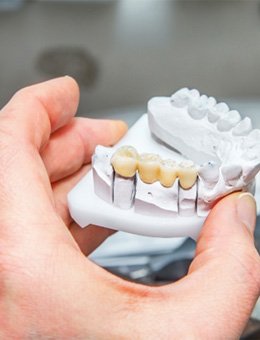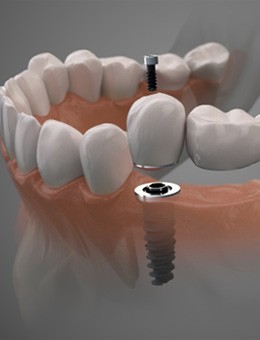Dental Bridges – Murphy, TX
Bridge the Gaps in Your Smile

When you’re missing teeth, you know how difficult it can be to complete daily tasks, like eating, speaking clearly, and showing off your smile with pride. If you have one or more missing teeth that need to be replaced, you’re in luck. At Murphy Family Implant & Cosmetic Dentistry, we offer customized dental bridges to restore the appearance and function of your teeth. To learn more about how you can bridge that gap in your smile, schedule an appointment with us. We’re eager to help you achieve a complete smile!
Why Choose Murphy Family Implant & Cosmetic Dentistry for Dental Bridges?
- Top-Tier, All-Ceramic Materials Available
- FREE Restorative Consultation
- Over 20 Years of Clinical Experience
What is a Dental Bridge?

A dental bridge is a type of restoration that is used to replace consecutive missing teeth – anywhere between one and four missing teeth in a row. The bridge is composed of two crowns and a number of replacement teeth known as “pontics.” The crowns will be anchored onto your adjacent teeth or dental implants depending on the type of bridge you get. This restoration can be made from a variety of durable, natural-looking materials.
Types of Dental Bridges

The type of bridge that you get will depend on both the location and the number of missing teeth you have. Here are the two different types:
Traditional Bridge
For patients who still have healthy teeth on either side of the gap that needs to be filled in, a traditional bridge is an ideal option. The teeth that support dental crowns are known as “abutment teeth,” and they need to be altered slightly for the bridge to fit properly. This type of restoration can be placed in just a few visits and is typically the most affordable type of bridge.
Implant Bridge
If you don’t have healthy teeth on each side of the gap, a surgically implanted metal post, also known as a dental implant, can provide an alternative option. Dental implants can be used when there are three or more missing teeth in a row. Implant bridges last longer than traditional bridges on average, and they help to prevent bone loss.
The Benefits of Dental Bridges

A dental bridge is a simple, yet cost-effective option for replacing missing teeth. Bridges are able to fill in gaps, and they also prevent the repositioning of the surrounding teeth. They also improve chewing function, improve speech articulation, and provide structure to the face to give you a more youthful appearance.
Dental Bridges FAQs

Dental bridges in Murphy are a tried and proven method of replacing 1 or more lost teeth. Although they’ve been used for decades, a bridge is a big commitment. We understand you might have some concerns before you are ready to commit to the procedure. Don’t worry, here are the answers to a few frequently asked questions to calm your nerves.
Can you take a dental bridge out?
No, dental bridges aren’t removable, unlike a partial. A bridge is designed to stay in your mouth for several years to provide a long-term solution for tooth loss. Only a trained dental professional can take it out. Typically, it is held in place by bonding dental crowns over the adjacent teeth; however, you can also use dental implants to anchor the bridge to your jawbone.
How many teeth can a dental bridge replace?
A bridge can be used to replace 1 to 4 missing teeth in a row. Although it’s possible to recreate up to 4 teeth, a bridge is most often recommended for 1-2 teeth. If the bridge is too long, it won’t have enough stability, which can cause damage to the supporting teeth. If you need to replace several teeth, an implant bridge may be the better option. A dental implant at either end of the bridge will provide unmatched stability and won’t rely on your remaining teeth for support to preserve your natural smile.
Are dental bridges covered by insurance?
Every plan differs, but many dental insurances can be used to offset the cost of a dental bridge. Most dental plans consider the restorations as a major procedure. Therefore, your benefits can cover 40% to 50% of the cost after meeting your yearly deductible. You can use your annual allowance to reduce your out-of-pocket expenses. A member of our team will file the necessary claim forms to maximize your dental benefits. If there’s any remaining balance, we offer several financial options to keep your bridge within your budget, like third-party financing.
Can dental bridges get cavities?
No, a bridge can’t get cavities; however, your supporting teeth are still vulnerable to decay. It’s not unusual for a cavity to occur where the crowns meet the gum line. Food debris or bacteria can get trapped in the small crevasse, causing decay to occur underneath the restoration. As your crown reaches the end of its lifespan, the cement holding it to your tooth can crack. Bacteria can gain access to the tooth through the fractures. Although this is a common cause of bridge failure, it is easy to prevent. Just like your natural teeth, good oral hygiene is crucial to keeping tooth decay at bay. Limit your consumption of sugary foods and drinks to safeguard your smile. Don’t forget to visit your dentist at least twice a year for a cleaning and checkup. They’ll examine your bridge at each routine appointment to ensure it is functioning as intended and there aren’t any concerns with the abutment teeth.
How Long Should a Dental Bridge Last?
On average, you can expect your dental bridge in Murphy to last somewhere between five and 15 years. While bridges made from metal generally have a longer lifespan than metal-free ones, the difference is often negligible. The lifespan of your restoration will depend in large part on individual factors such as your diet, oral hygiene, and whether you have any bad oral habits (e.g., smoking, nail-biting, teeth grinding, or eating ice). Where your bridge is placed in your mouth will also influence how long it lasts. Bridges that replace front teeth may last slightly longer than those toward the back of the mouth, as they’re not subjected to as much wear and tear from chewing.
Do Dental Bridges Feel Natural?
Yes! Every bridge is custom-crafted based on impressions taken of the tooth. Therefore, your bridge should not feel awkward or uncomfortable at all. Instead, within just a few days of receiving your permanent dental bridge, it should start to feel increasingly natural. You will also be able to continue eating many of your favorite foods without worry! Bridges are made from durable materials that can stand up to everyday chewing forces, so eating with a bridge shouldn’t feel strange. If you run your tongue across an arch of your teeth, the bridge may feel slightly different to the touch than the rest of your teeth. For the most part, though, a dental bridge should feel so natural that you might end up forgetting you even lost your teeth in the first place!
What Are Dental Bridges Made Of?
In general, dental bridges can be made from the same materials as dental crowns, including gold or metal alloys. At Murphy Family Implant and Cosmetic Dentistry, we often use tooth-colored porcelain and zirconia to ensure your restoration blends in seamlessly with your surrounding smile. The material that’s ideal in your case will depend on your specific needs. During a consultation, your dentist in Murphy will explain their reasons for the recommendation they make for you.
How Do I Clean Under My Dental Bridge?
You will need to clean your bridge daily to prevent bacteria from gathering on the gum tissue underneath and potentially causing it fail. There are a few different ways to clean under a dental bridge in Murphy, so you may need to try them all to find the one that’s easiest for you. Here are the three most common techniques:
- Floss and Threader – First loop a piece of dental floss through a threader, then slide the pointed end underneath the bridge and out the other side. Next, slide the floss back and forth under the restoration. Finally, wrap the floss around each of the supporting teeth/implants to clean just beneath the gums there.
- Interdental Brush – Also called “Christmas tree brushes,” these tools contain puffy bristles that are attached to a wire. With their long handles, it’s easy to slide them in and out of the space under your bridge to remove food debris.
- Water Flossers – Waterpiks and other such devices release a steady stream of water, which you can aim underneath your bridge. Water flossers come in many varieties, so you can choose the pressure level and tip design that works for you.
